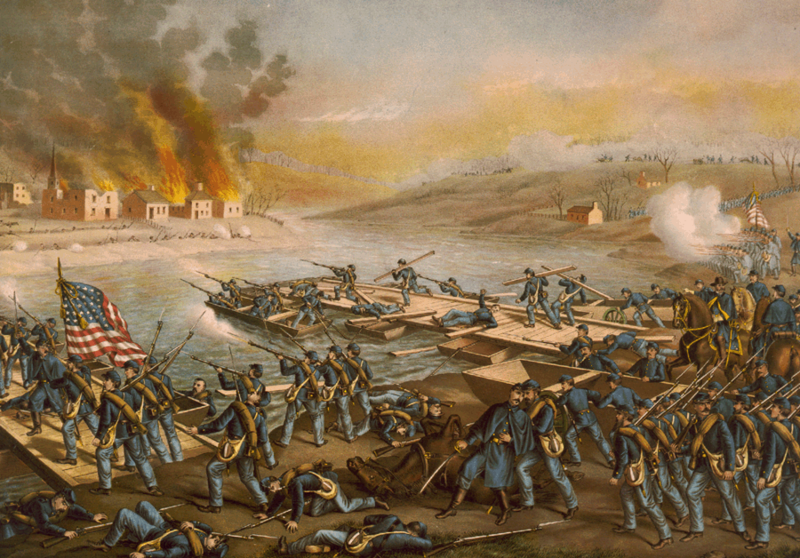
Constructing the Pontoon Bridges across the Rappahannock, by Allison and Kurtz.
Today is the 150th anniversary of one of the bloodiest and most lopsided battles of the American Civil War: Fredericksburg. It was in response to this battle that the victorious CS General Robert E. Lee commented: "It is well that war is so terrible, otherwise we should grow too fond of it."


CS General Robert E. Lee (left) and US General Ambrose E. Burnside (right).
Following the bloody mess at the Battle of Antietam, Maryland, in September 1862, both armies, the Confederate Army of Northern Virginia, commanded by Robert E. Lee, and the Union Army of the Potomac, marched south back into the Old Dominion. Lee saw to the retreat of his smaller force the night of 18 September. For the Army of the Potomac, the crossing of the Potomac into Virginia didn't happen until 26 October, and a great deal of prodding by President Abraham Lincoln. This delay, along with the poor working relationship between the President the commander of the US Army of the Potomac, General George McClellan, resulted in the removal of the latter from command on 5 November 1862. The new army commander: US General Ambrose E. Burnside of Rhode Island.

Arrival at Fredericksburg -- the campaign from mid-November to the Union Rappahannock Crossing. [Map by Hal Jespersen, www.cwmaps.com]
Lee, unsure of the next move by the Union army, by 18 November had half of his army in the Shenandoah Valley, near Winchester, Virginia, under the command of CS General Thomas "Stonewall" Jackson, and the other half at Culpeper, Virginia, under CS General James Longstreet.
Burnside, for his part, resolved to strike south for Fredericksburg, Virginia, on the Rappahannock River, and a railhead to a line straight south to the Confederate capital of Richmond. The Army of the Potomac, now with corps grouped into Grand Divisions, actually had its vanguard arrive in Falmouth, Virginia, across the Rappahannock River on 17 November, with hardly a Confederate in sight. A delay in the arrival of pontoon bridges, however, mean that by the time Burnside's army crosses the river on 11 December, Lee was waiting for him (Jackson had finally arrived on 1 December). US General Ambrose Burnside commanded a force of 115,000, while CS General Robert E. Lee opposed him with 78,000.

Map of the actions of 13 December 1862 at Fredericksburg. [Map by Hal Jespersen, www.cwmaps.com]
13 December 1862 was the day of Burnside's aggressive assaults, which raged in two portions of the battlefield.
In the south, the Division of George Meade's Pennsylvanians, part of the I Corps, launched an attack across a railroad line to strike the right flank of the Confederate army, commanded by Stonewall Jackson. This attack, starting at 8:30AM would smash the Bridge of Maxcy Gregg and his South Carolina troops, but would be bogged down by Jackson's reserves which would throw the attack back from Prospect Hill. This would be the area of the Union's greatest success of the day.
In the north, on the Confederate left and Union right flanks, Longstreet's Corps defended Marye's Heights, which sat west of the town, with a stonewall running along its base. The Union forces, those of the II Corps, would have to pass through Fredericksburg, across a canal, march over a large upon field, and storm a stone wall to strike their Southern foes. Fifteen brigades worth of trying did not see a single Union soldier touch the wall. It was a bloody massacre on this end of the field of battle.
Here is the NPS account of the battle: http://www.nps.gov/history/hps/abpp/battles/va028.htm
This is a link to the Fredericksburg and Spotsylvania National Military Park, where these events took place: http://www.nps.gov/frsp/fred.htm
A single day of battle yielded 12,600 Union casulaties at a cost of 5,300 for the Southern Confederacy. Despite Burnside's initial determination to personally lead a charge the next day, on the night of 15-16 December, in frigid rain, the Army of the Potomac slinked back across the Rappahannock defeated by the Army of Northern Virginia. Mention should be made of Sgt. Richard Kirkland, a South Carolinian that jumped the stone wall, at risk of his own life, to give water to wounded Union soliders -- he, the "Angel of Marye's Heights."
Another Union lunge into Virginia had been parried, and Yankee morale was grim, indeed, that winter of 1862 in the East. Lincoln would have to look west for consolation that winter.
Live well!
No comments:
Post a Comment